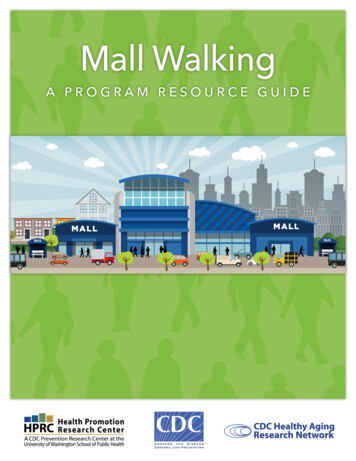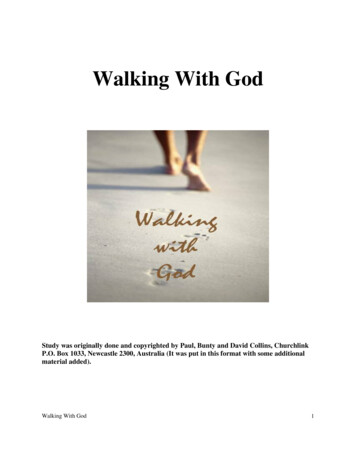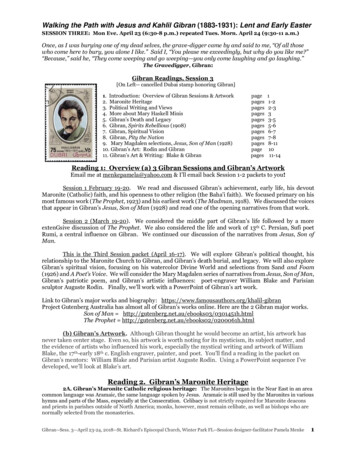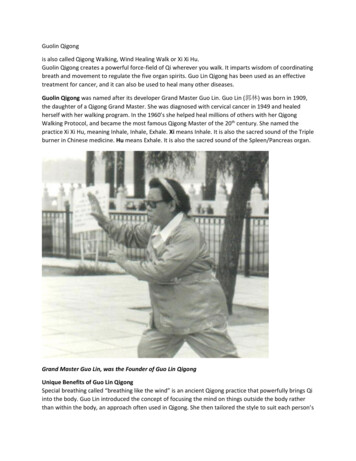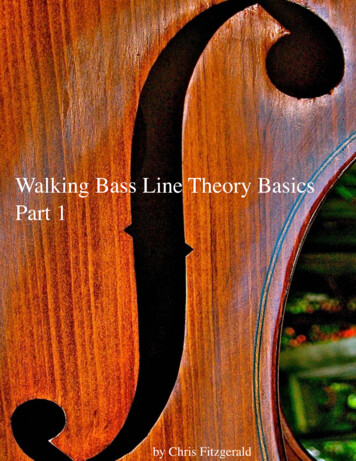
Transcription
Walking Bass Line Theory BasicsPart 1by Chris Fitzgerald
Walking Bass Line Theory Basicsby Chris FitzgeraldTarget Note: a note that is played with the intent to outline a chord in a chord progression,usually on the first beat that the chord appears within the progression. Forbeginning bass lines, the Root of the chord is the most common target noteto play because it is the fundamental note of the chord.Approach Note: a note that leads into a target note in an aurally logical way. Approach notesusually occur on the beat before a target note.Harmonic Rhythm: the rate at which chords change in a progression. In 4/4 time the mostcommon harmonic rhythms are one chord per measure or two chordsper measure. It is common for the harmonic rhythm to vary within mostchord progressions.When the harmonic rhythm of a progression of a song is two chords per bar, the bass playerwill often play a target note on beats 1 and 3, and an approach note on beats 2 and 4.The following is an example of a common bass line construction when the harmonicrhythm is moving at the rate of two chords per bar (Target notes are designated with "T",and approach notes are designated with "A").chordEx. 1chordchordchord?4 T4ATATATA(Beat) 12341234Since the root is the most common target note used in beginning bass lines, a bass linefor the following progression could be constructed as follows:Ex. 2Dmi7G7Cmi7? œAœA(Beat) 1234œ1F7AœA234
Walking Bass Line Theory Basics - Chris Fitzgerald2Where the harmonic rhythm is one chord per bar, the groups of target and approach notesare separated by two beats of space where the player has to decide how to fill the spacebetween them.Ex. 3?chordchordT123AT4123chordchordATT412341A234Using the root for each target tone, a bass line for the following progression could beconstructed as follows (notes on beats 2 and 3 are designated with question marks here):Ex. 4Dmi7G7? œ? ?123Cmi7F7Aœ?Aœ ? ? Aœ?A4123411234234Based on the preceeding examples, it could be argued that the concept behind much bassline construction (at least in the beginning stages) could be simplified down to the followingbig-picture formulas:Where the harmonic rhythm is two chords per bar, the player is thinking only about targetnotes and how to approach them (same as Ex. 1):Ex. 5chord? TchordchordTATAchordATAWhere the harmonic rhythm is one chord per bar, the player is thinking about a targetnote on beat one, an approach note on beat four, and two variable notes to flesh out theharmony and lead to the next aproach note:Ex. 6?chordTchord?AT?A
Walking Bass Line Theory Basics - Chris Fitzgerald3Observation: the preceeding examples illustrate an important point - progressions thatfeature a faster harmonic rhythm may be difficult to execute on the instrument (especiallyat faster tempos) because of the number of details that need to be realized in order for theoutlining of the progression to take place, but they are actually very simple on a conceptuallevel because the player is left with fewer choices to make than when the chords are spacedfarther apart. In Ex. 5, assuming that the target note chosen will be the root, the player's onlyreal time choice is what kind of approach note to use. In Ex. 6, the player has two open-endedchoices to make for each chord change in addition to choosing the type of approach note touse to lead into the next target. In progressions where the harmonic rhythm is even slower(i.e. - where there is a new chord only every two, four, or eight bars), this effect is multiplied,resulting in many more decisions which must be made by the player in real time.At this point, for the level of bass line construction we are discussing, the root of eachchord is usually the best choice for the sake of simplicity of thought and clarity of theoverall musical result. This leads us to a discussion of the different types of approachnotes commonly found in walking lines.Types of Approach Notes: earlier in this document, we defined the term "Approach Note"as "a note that leads into a target note in an aurally logical way". The key question, then,is how to define the words " aurally logical". For our purposes here, we'll examine twogeneral categories of approach notes, then get into more specific details of each from there.Non-Stepwise Approach Notes: as the name suggests, these are approach notes that leadto the target note of the next chord change by intervallic leap rather than by step. The mostcommon way that this is done while still maintaining the "aural logic" mentioned above isto jump to the target note from a chord tone that is part of the previous harmony. Anexample is given below:Ex. 7B 7R? bœE 7R? bœF735E 77Rœ bœœ7bœœ bœ3bœ5RE 7œ bœ3bœB 753RœbœE 73nœ353R33œœB 7357Rbœœ bœ53B 7R3b œ nœ35R3œ bœ3œ bœœbœB 7? œ nœ œ œ b œ œ b œ œ b œ œ œ b œR5B 7753œœF7Rœbœœ nœ œ œR35R55B 7bœRR7
Walking Bass Line Theory Basics - Chris Fitzgerald4In this example, the bass line consists of simple arpeggiations of each chord, giving theoverall effect of a simple blues bass line. A slightly embellished version of this kind of linewould also be typical of a basic "boogie woogie" type bass line, as in the following example:Ex. 8B 7?R3bœœE 7R? bœF7?R5655bœ67œœ bœ3bœœœ376766œ5œ65œ bœ533œ3œB 7RB 7R3bœœ56œœ76bœœœR3b œ nœ33œ*B 75656œœ7676bœ5œ3œ œ bœ œ œ œbœœœœœœœ bœœ nœ*55œ3œB 7bœWhile both of the previous examples are certainly "aurally logical" and fairly typical ofthe style, it could be argued that when it comes to the connections between each chordand the next, most of the "approach tones" that occur right before the root of the next chordaren't really approach tones at all but are rather simply part of the preceeding harmony. Inother words, in all the lines above, if the music were to stop on beat four right before a newchord was about to be outlined, the listener would have a great sense of what harmony hadjust been played but little or no sense of what the next chord root was likely to be if theydidn't already know the progression. But two of the approach note resolutions in Ex. 8,marked by asterisks above, are arguably stronger and more compelling resolutions becausein addition to continuing the ornamented arpeggio pattern that the line begins with, they alsoresolve to the root of the next chord by step rather than by leap. This leads us to the discussionof stepwise approach notes.Stepwise Approach Notes: as the name suggests, stepwise approach notes are notes that leadinto a target note by stepwise motion (i.e. - by half step or whole) rather than by a musicalleap. If we look at these scientifically, there are four different kinds of stepwise approach notes:- approach by whole step from above- approach by whole step from below- approach by half step from above- approach by half step from below
Walking Bass Line Theory Basics - Chris Fitzgerald5Stepwise motion fits the definition of "aurally logical" perfectly because of the way thiskind of approach note leads directly into the target note that follows it. While the fourtypes of stepwise approach notes above cover all four possible ways that stepwiseapproach notes could occur in a line, for the purposes of deciding how to use each kindof approach note in the moment, it is useful to further group stepwise approach notes intotwo basic categories: Diatonic approach notes, and Chromatic approach notes.Diatonic Stepwise Approach Notes: in general musical usage, the term "diatonic" meanswithin the tonality or scale without chromatic alterations. For our purposes, this means thata diatonic approach note would already exist within the chord currently being played, or bechosen from the scale tones between the chord tones that would be considered within thetonality of that chord. Because of this, we can make several general observations aboutdiatonic stepwise approach notes:- They tend to sound very logical, and don't challenge the ear by bringing in notes fromoutside the key.- Because they are part of the tonality that's happening, they don't create dissonant clasheswithin the line; in other words, they almost never sound "wrong".- Because most scales and tonalities contain both half and whole steps, a stepwise diatonicapproach note can be any of the four types of stepwise approach notes listed above.- Because this type of approach note is by definition "from within the key", the player musthave a solid theoretical knowledge of the progression being played in order to play themconsistently.This last point is important, especially when you stop to consider that walking bass lines areusually constructed and executed in the moment. Players who consistently construct logicallines are usually those who have absorbed the concept and sound of line construction overa period of years to the point where the theoretical concepts have been absorbed andinternalized so completely that they are automatic. In musical execution, as in most otherskills, thought and creativity share the same mental bandwidth; the more you have to thinkwhile in the flow of the activity, the less creative you can be. For this reason, it's a good ideato practice creating each type of approach note systematically in the practice room, so thatwhen it comes time to perform, you can do so with as little thought as possible devoted tomusic theory in order to leave your mental bandwidth free to hear and create melodic ideas.The next few examples will explore how the concept of stepwise diatonic approach notescould be applied to a chord progression like the first 8 bars of the song "I Got Rhythm",commonly known as "Rhythm Changes".Ex. 9? bbB G7Cmi7F7Dmi7G7Cmi7F7B 7 /DE E07 B /FG7Cmi7F7
Walking Bass Line Theory Basics - Chris Fitzgerald6(Note: while there are many ways to harmonize the Rhythm Changes progression, thesechords were chosen because they are pretty standard and because they maintain a consistentharmonic rhythm, which helps us focus on the approach notes)If we fill in the root of each harmony (or the bass note where the chord is in inversion),the result would look something like this:Ex. 10B ? bb œ ŒB 7G7Cmi7œ Œœ ŒE B 7/D? bb œ Œ œ ŒF7œ ŒE07Dmi7œ ŒB /FG7œ ŒG7Cmi7œ Œ œ Œœ Œ nœ ŒCmi7F7œ Œœ ŒF7B œ Œ œ ŒœNext, we'll fill in diatonic stepwise approach notes that approach each target from above(approach notes drawn without stems):Ex. 11B G7Cmi7?bœ œ œ œbB 7B 7/DœE F7œ œ œE07œ œ nœ œ?bœb œ œ œB /FDmi7G7œ œ œ œG7œ œ œ œCmi7Cmi7œF7œœœœF7œ œœB œNow we'll fill in diatonic stepwise approach notes that approach each target from below:Ex. 12B G7Cmi7? bb œ œ œ nœB 7B 7/D? bb œ œ œ œF7œ œ œ œ*E E07œ œ nœ œB /FDmi7G7G7Cmi7œ œ œ nœ*œ œ œ nœ*Cmi7F7œ œ œ œF7œœ œ œB œ
Walking Bass Line Theory Basics - Chris FitzgeraldThere are several notable things about the approaches from below in the previousexample:- Where there is an approach note in the duration of the G7 chords leading to C, the B flatis raised to a B natural, because B natural is the 3rd of the G7 chord.- There are a fair number of repeated notes in the line where the motion of the chord rootsis stepwise. In spite of an "urban myth" to the contrary, it is common for walking bass linesto include repeated notes where they make musical sense to the player.7Last, we'll close this section on diatonic stepwise approach notes with an example that mixesboth upper and lower diatonic approach notes:Ex. 13B G7? bb œ œ œ œB 7B 7/D?bœb œ œ œCmi7F7œ œ œ œE E07œ œ nœ œB /FDmi7G7œ œœG7œ œ œ œnœCmi7Cmi7F7F7B œ œ œ œœœ œ œœChromatic Stepwise Approach Notes: While the term "chromatic" has several differentmusical definitions, for our purposes here we'll define chromatic approach note as anote that resolves to a target note by half step from either above or below. This definitionallows us to greatly simplify the matter, because by using it we no longer need to concernourselves with whether or how a note fits into an existing tonality or scale; rather, bydefining the term this way, we admit that what makes this type of note work is its strongtendency to resolve rather than how it fits into a tonality or scale. We can make severalobservations about chromatic approach notes:- While the upper and lower chromatic aproach notes sound different from each other,both resolutions have an unmistakable sonic logic to them, even when the approach notetaken out of context would be a "wrong note" in terms of the tonality or scale of the moment.- They require no theoretical knowledge on the part of the player other than how to playa half step above or below a target note on the beat right before the target note is played.- Some diatonic approach note resolutions, both from above and below, are by half step:for example, in the excerpt above, the diatonic approach note resolution "Eb to D" at theend of measure 2 is an example of a descending stepwise approach note that is bothdiatonic and chromatic; likewise, the ascending "A to Bb" resolution at the end of measure 8is an example of an ascending stepwise approach note that by our definition is both diatonicand chromatic.- In light of the last point made above, a chromatic approach note will not necessarily haveto be written with an accidental when written in musical notation.
Walking Bass Line Theory Basics - Chris Fitzgerald8The following example continues our exploration of building lines on Rhythm Changes byapproaching each target note with a chromatic approach note from above (notes that arealso diatonic approach notes are marked with an asterisk):Ex. 14B G7? b œ bœ œ bœbB 7 * B 7/DCmi7F7*bœœœœE *E07? bb b œ œ œ nœ b œ œ nœ b œB /FDmi7G7œ b œ nœ b œG7œ b œ nœ b œCmi7Cmi7F7œ b œ œ nœF7nœœ bœ œB bœNotice the way that many of the upper chromatic approach notes sound dissonant againstthe key of the chord progression. This can be somewhat disconcerting to many beginners toline building, but in fact it is neither a good thing or a bad thing; rather it is something tosimply be aware of. The dissonance or "wrongness" of these notes is actually the very thingthat makes their resolution to a "
Walking Bass Line Theory Basics - Chris Fitzgerald 6 5 3 R 3 5 6 7 6 5 * 3? R 3 5 6 7 6 5 3 R 3 5 6 7 6 5 3? While both of the previous examples are certainly "aurally logical" and fairly typical of the style, it could be argued that when it comes to the connections between each chord and the next, most of the "approach tones" that occur right before the root of the next chord aren't really .File Size: 419KBPage Count: 11



